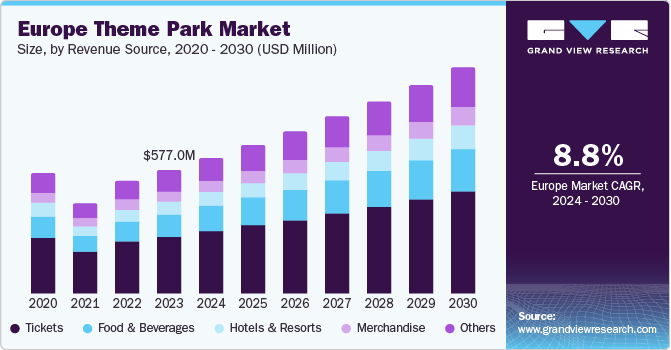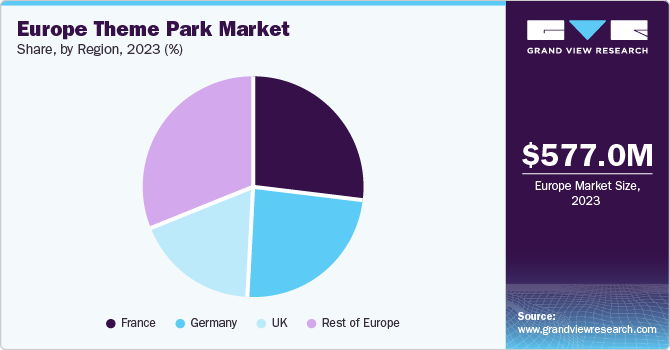- Home
- »
- Digital Media
- »
-
Europe Theme Park Market Size Report, 2030GVR Report cover
![Europe Theme Park Market Size, Share & Trends Report]()
Europe Theme Park Market Size, Share & Trends Analysis Report By Revenue Source (Tickets, Food & Beverages, Merchandise, Hotels & Resorts, Others), By Country (UK, Germany, France), And Segment Forecasts, 2024 - 2030
- Report ID: GVR-4-68039-270-4
- Number of Report Pages: 80
- Format: PDF, Horizon Databook
- Historical Range: 2018 - 2022
- Forecast Period: 2024 - 2030
- Industry: Technology
Report Overview
The Europe theme park market size was valued at USD 577.0 million in 2023 and is projected to grow at a compound annual growth rate (CAGR) of 8.8% from 2024 to 2030. The market is primarily driven by the increasing disposable income among European consumers coupled with the growing population, which is more inclined to spend on entertainment and travel. In general, theme parks are categorized into mega parks, Tier 1, Tier 2, and Tier 3 parks. Most of the people visiting mega parks are those who prefer fancy rides. The theme parks majorly influencing the regional market growth fall under the small park or Tier 3 category. Such parks offer various options for entertainment, including historic playgrounds, classic city-park charmers, and lively adventures. Rising tourism expenditure and increasing middle-class and urban population are some of the key factors driving the market growth.

Furthermore, Europe remains a top destination for international tourists, and theme parks have been major attractions within this sector. The easing of travel restrictions and the resurgence of international travel have led to higher visitor numbers at theme parks. Moreover, domestic tourism has witnessed a boost as Europeans explore attractions within their own countries, further driving the market.
In addition, theme parks have been increasingly incorporated with cutting-edge technologies such as virtual reality (VR), augmented reality (AR), and interactive experiences to enhance visitor engagement and satisfaction. For instance, Europa-Park in Rust in Germany offers VR on its Alpenexpress Coastiality and Eurosat Coatiality coasters, and Efteling is a Dutch theme park that offers the VR version of its “dreamflight” attraction. These innovations have increasingly attracted tech-savvy visitors and provide unique experiences that differentiate parks from their competitors. The integration of technology extends to operational aspects, with many parks adopting digital ticketing systems and dynamic pricing models to streamline operations and improve customer convenience.
Moreover, theme parks have expanded their offerings beyond traditional rides to include a variety of entertainment options such as live shows, themed events, and interactive exhibits. Such diversification helps attract a broader audience, including families, young adults, and even senior citizens. Additionally, parks have increasingly invested in seasonal events and special promotions to maintain visitor interest throughout the year.
Theme parks have progressively leveraged social media and digital marketing to reach potential visitors more effectively. Influencer partnerships, targeted advertising, and engaging content are some of the key strategies that drove significant traction. In addition, they have increasingly partnered with entertainment companies and movie studios to create themed attractions and unique, immersive experiences.
Revenue Source Insights
Tickets have secured the dominant market share in 2023 with dynamic pricing models that allow parks to adjust ticket prices based on demand, seasonality, and special events. This flexibility helps maximize revenue by attracting visitors during off-peak times with lower prices while capitalizing on high-demand periods with premium pricing. Additionally, the shift towards online ticketing has streamlined the purchasing process, making it more convenient for visitors to buy tickets in advance. This enhances the customer experience and provides parks with valuable data for better forecasting and inventory management. Furthermore, parks have often offered special deals during holidays, school vacations, and other peak times to attract families and groups. These promotions have been heavily marketed through digital channels, including social media and email campaigns. Moreover, flexible ticket packages that include multi-day passes, family bundles, and annual memberships encouraged repeat visits.
Food & beverages are expected to grow substantially at a CAGR of 9.5% over the forecast period. Theme parks have increasingly offered diverse and high-quality food options, ranging from gourmet meals and themed snacks, to cater to varied tastes and preferences. This strong focus on culinary experiences enhances the overall visitor experience and encourages higher spending within the parks. In addition, theme parks often implement dynamic pricing strategies, offering meal deals, combo packages, and seasonal discounts to attract visitors.
Country Insights
The France theme park market held a dominant market share of 26.9% in 2023 owing to rising disposable incomes and increased consumer spending on leisure activities. As the French economy continues to recover post-pandemic, families and individuals have been increasingly willing to spend on entertainment, including theme parks. These parks have widely expanded their offerings beyond traditional rides to include a variety of entertainment options such as live shows, themed events, and interactive exhibits. Such diversification has helped maintain visitor interest throughout the year.

The UK theme park market is expected to grow substantially over the forecast period.The market is expected to be significantly driven by technological advancements such as AR, VR, and interactive, immersive experiences to enhance visitor engagement with unique experiences. Additionally, the integration of digital ticketing systems and mobile apps has streamlined operations and improved customer convenience. Furthermore, several UK theme parks such as Alton Towers, Thorpe Park Resort, and others have adopted eco-friendly practices and promoted sustainability to appeal to environmentally conscious consumers. These efforts include reducing waste, conserving energy, and using sustainable materials.
Key Companies & Market Share Insights
The competitive landscape of the theme park market in Europe features Disney, Ancient Kiev, Astrid Lindgrens Näs, and others. These key participants have continuously invested in new attractions and upgrading existing ones to stay ahead of the competition. This competitive pressure has significantly driven innovation and ensured that parks remain attractive to visitors.
-
Disney is a world-renowned entertainment conglomerate that has grown to be a global powerhouse encompassing theme parks, resorts, movies, TV programs, and streaming services.
-
FunPark Ordnung, also known as Playmobil-FunPark, is a unique family-friendly theme park. It is designed around the popular Playmobil toy brand and offers a variety of interactive play areas and attractions that bring the toys to life. FunPark Ordnung focuses on imaginative play and hands-on experiences.
Key Europe Theme Park Companies:
- Ancient Kiev
- Astrid Lindgrens Näs
- Disney
- FunPark Ordnung
- Liseberg
- High Chaparral
- Moomin Characters
- Watermouth Castle
- Puy du Fou
- PortAventura
- Energylandia Park Rozrywki
- Kolejkowo
Recent Development
-
In February 2024, Universal began its meetings for theme part in the UK. The company confirmed in December 2023, that it bought 476-acres land near Bedford, to transform it into an attraction.
Europe Theme Park Market Report Scope
Report Attribute
Details
Market size value in 2024
USD 631.9 Million
Revenue forecast in 2030
USD 1,048.1 Million
Growth rate
CAGR of 8.8% from 2024 to 2030
Base year for estimation
2023
Historical data
2018 - 2022
Forecast period
2024 - 2030
Quantitative units
Revenue in USD million and CAGR from 2024 to 2030
Report coverage
Revenue forecast, company ranking, competitive landscape, growth factors, and trends
Segments covered
Revenue Source, Country
Country scope
UK, Germany, France
Key companies profiled
Ancient Kiev; Astrid Lindgrens Näs; Disney; FunPark Ordnung; Liseberg; High Chaparral; Moomin Characters; Watermouth Castle; Puy du Fou; PortAventura; Energylandia Park Rozrywki; Kolejkowo
Customization scope
Free report customization (equivalent up to 8 analysts working days) with purchase. Addition or alteration to country, regional & segment scope.
Pricing and purchase options
Avail customized purchase options to meet your exact research needs. Explore purchase options
Europe Theme Park Market Report Segmentation
This report forecasts revenue growth at region levels and provides an analysis of the latest industry trends in each of the sub-segments from 2018 to 2030. For this study, Grand View Research has segmented the Europe theme park market report based on revenue source and country.
-
Revenue Source (Revenue, USD Million, 2018 - 2030)
-
Tickets
-
Food & Beverages
-
Merchandise
-
Hotels & Resorts
-
Others
-
-
Country Outlook (Revenue, USD Million, 2018 - 2030)
-
UK
-
Germany
-
France
-
Share this report with your colleague or friend.
![gvr icn]()
NEED A CUSTOM REPORT?
We can customize every report - free of charge - including purchasing stand-alone sections or country-level reports, as well as offer affordable discounts for start-ups & universities. Contact us now
![Certified Icon]()
We are GDPR and CCPA compliant! Your transaction & personal information is safe and secure. For more details, please read our privacy policy.
We are committed towards customer satisfaction, and quality service.
"The quality of research they have done for us has been excellent."





